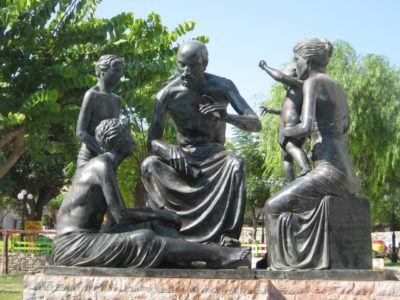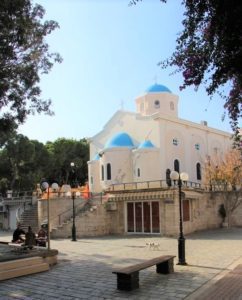Visit Kos town
Kos town, the capital of the island of Kos with a population of 19,000 inhabitants, offers in its little much more than you would expect. Focal point of the city is the lively harbor promenade and the old town. The waterfront is characterized by the cafeterias and restaurants set in the shade of giant fichus trees while on the other side typical gulets are promoting excursions to the nearby islands and Turkey.
The harbor area has a long pedestrian and cycling lane that connects to the location Psalidi on the one hand and the other to Lambi. Ideal for a walk or a bike ride at all hours of the day and evening. The cycling lane pass through the city close to many hotels, shops, cafes and restaurants, that make cycling extremely popular by the tourist and locals.
Dolphin Square is one of the famous meeting points in Kos town, easily recognizable by the decorative fountain in the center. From there you can continue along the Kanari street, a modern area teeming with shops of all kinds open every day until late.
Absolutely should not miss a walk along Averoff street there are all the seaside fish taverns and restaurants. This street is known for offering the best fish taverns of Kos town. At the side of Averoff street begins the sandy beach of Kos town, a beach full of beach bars and entertainment that joins at the end, the quieter called Lambi.
The most interesting area of the city of Kos, however, is undoubtedly the one that stands out among the narrow streets known as the old town of Kos. The historic center of Kos town bears evidences of ancient Greek and Roman until the liberation and re-union with Greece.
Old town of Kos
We advise you to start your visit to Kos town from the impressive Fortress of the Knights of St. John. Offers a very charming exterior with its double walls and towers, but the poor contained within. The entrance is located at the Square of Hippocrates’ Plane which is connected to the fortress by a charming stone bridge. Along with the Hippocrates’ Plane, is one of the architectural symbols representing the island of Kos. Inside the fortress can be seen some remains of the ancient city and one of the best views over Kos harbor.
In the nearby Platanos Square you can see the mythological tree, a huge plane tree, with the empty trunk. According to legend, the tree, under whose shade Hippocrates taught the art of medicine to his students, should have more than 2500 years. But this tree has about 600 years and is one of the oldest in Europe. Behind the Plane Tree there is the Great Mosque of Gazi Hassan Pasha build in 1786 property of the Turkish minority in Kos. Long time not used as a place of prayer. In the shops below shops you can be purchased different souvenirs including the famous Hippocratic Oath translated into several languages.
The white building to the side of the Fortress is the Palace of the Regency, dating back to the Italian administration. This Palace today hosts the court of the island and the Office of local Police and Justice. Opposite side, under a huge fichus Benjamin, are the Ottoman era baths known as hammam. Much of the history of Kos is witnessed in this beautiful square from which you can also see the ruins of the ancient Agora; it was the political, commercial and social life of the Hellenistic period.
Agora and main squares
Ancient Agora of Kos can be accessed from several entrances, but the most conveniently located is on the pedestrian street called Bar Street in Kos, a boulevard with many clubs open only in the evening. The entrance to the Agora site is free of charge. You can admire the ruins of the temples of Hercules and Aphrodite, the columns of the Stoa and many other artifacts that archaeologists are still bringing to light. Continuing along the Bar Sreet you get to Elefhteria Square (Piazza della Liberta in Italian), the main square of Kos town‘, surrounded by buildings built during the years of Italian colonization after the earthquake of 1933.
The neoclassical building is the Archaeological Museum which houses artifacts dating back to the Hellenistic and Roman period. Beside the museum is the Tower with the clock and the Palace of the Circle, today’s cinema of Kos and interesting Mosque Defterdar, also no more used for worship. The square hosts several cafes and the modern Agora, a tourist market open every day till late. Here you can find several souvenirs and local products such as herbs, spices, honey named after Hippocrates ( thyme honey), olive oil, skin care products, as well as fruits, vegetables and other products from the island of Kos.
Around the square and along the Eleftheria Veneizelou road there are all kinds of shops that work all year round keeping the same hours (afternoon closing from 13 to 17 / closed on public holidays). In contrast, the tourist shops of Ifestou street between the Market and the Palace are open every day until late evening. Along this cute pedestrian alley are jewelers, silverware, pottery shops, textiles and various souvenirs shops, as well as numerous cafes and bars.
Walk through the West of Kos town
The continuation of the street Ifestou is named Apellou that ends in the Diagora Square, a small square surrounded by several restaurants and famous for the presence of one of the few monuments left standing after the earthquake of 1933, the Minaret. Turning down behind the Minaret you reach the archaeological site west of Kos town. It is a site large site, very beautiful and rich in content, very quiet visited by few tourists.
On the left side you can see the old residential area with the remains of houses decorated with mosaics, the most famous of which is The Kidnaping of Europe. The walk along the old road will take you to the Nympheon, or public baths close to public, the columns of the Stadium and the stunning remains of the baths used by the Romans.
On the other hand, across Grigoriou Street, you can visit the small theater called Odeon. The concave opening has nine marble rows that have been restored, a landing and then another five rows made of granite. The lower stands made of marble were for the more “respectable” citizens while the higher stand made of stone was for the remaining spectators.
Finally, after the theater near the municipal parking, there is the Casa Romana of Kos town, a patrician house decorated with beautiful mosaics. Beside of Casa Romana you will find the new and interesting museum dedicated to Italian period on the island of Kos where you will discover projects and works done by Italians during the period of fascism on Dodecanese islands.








